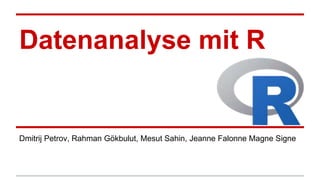
Datenanalyse mit R
- 1. Datenanalyse mit R Dmitrij Petrov, Rahman Gökbulut, Mesut Sahin, Jeanne Falonne Magne Signe
- 2. Agenda 1. Einführung in das Projekt 2. Einführung in R 3. Explorative Datenanalyse 1. Korrelation & Histogramme 2. Test auf Normalverteilung und QQ-Plot 3. Potenz Transformation (Box-Cox) 4. Lineares Modell 4. Interaktive Aplikation mit Shiny Framework 5. Zusammenfassung
- 3. 1.Einführung in das Projekt ● Datensatz: Facebook Statistiken über 576 Fan Page-Beiträgen ○ Fan Pages wurden unterschieden auf: ■ Service & Produkt Community ● Ziel: Wie wird User Engagement von Acquaintance beeinflusst? ● Methoden: Statistische Analyse mit R
- 4. 2. R ● Statistik Software o von Ross Ihaka und Robert Gentleman in 1991 entwickelt [1] o seit 1995 unter GNU GPL ● Ist eine Implementierung von S (John Chambers et al. @ Bell Labs 1976) [2] ● Erst aber 2000 stabil und aktiv von R Core Group weiter entwickelt ● Heute >2 Implementierungen: S-PLUS (commerziel) und R (GNU GPL) o mit vielen weiteren Distributionen: Revolution R Open (ab 1Q. 2015 Microsoft) Oracle R Enterprise
- 5. R ● Geschrieben in C (35%) & Fortran (24%) & R (38%) ● Objekte & Daten werden explizit im RAM gespeichert o 100 Millionen x 5 Matrix 4 GB RAM [3] ● Sehr umfangreich o Funktionalität in modularen Pakete aufgeteilt (z.B. von CRAN oder GitHub zum herunterladen) ● Heute populär bei Forschern für Data Mining Zwecke o statt SPSS, SAS, Stata usw., siehe TIOBE Index [4]
- 6. 3. Explorative Datenanalyse (EDA)
- 7. Korrelation ● Beschreibt eine Beziehung zwischen ein oder mehreren Merkmalen o muss aber keine Ursache-Wirkung-Beziehung (Kausalität) bestehen ● Korrelationskoeffizient r als Maß der Beziehung o -1 = "Starker negativer Zusammenhang" o 0 = "Kein Zusammenhang" o 1 = "Starker positiver Zusammenhang" Variable/Datensätze Produkt Service Gemeinsam User Engagement <-> Acquaintance 0.70 0.63 0.54
- 8. Streudiagramm "Graphische Darstellung von beobachteten Wertepaaren zweier statistischer Merkmale" [5] ● Wertepaare werden als Punkte dargestellt ● Das Muster gibt Infos über die Abhängigkeit der beiden Merkmale
- 9. Diagramm von “Service” Merkmalen r = 0.63
- 10. Schritte zum Linearen Modell
- 11. Histogramm von User Engagement
- 12. Normalverteilung ● Bezeichnet eine wichtige Form der Wahrscheinlichkeitsverteilung o Aussehen und Eigenschaften werden von Erwartungswert und Varianz bestimmt [6, 7] o Benutzt z.B. bei der annäherten Beschreibung von Körpergröße, Einkommen usw.
- 13. Histogramm von User Engagement
- 14. Überprüfung auf die Normalverteilung ● Verschiedene Möglichkeiten, wie z.B. Chi-Quadrat-Test, QQ-Plot usw. ● QQ-Plot: o vgl. die Quantile der Normalverteilung Quantile der Daten o Wenn Punkte annähernd auf einer Geraden liegen normalverteilt
- 15. QQ-Plot von User Engagement
- 16. Box-Cox (Potenz) Transformation ● Frage: Finde einen Lambda Wert, sodass die Punkte von dem QQ-Plot möglichst gut auf der Gerade liegen, was auch zu der größten Korrelation führt [8] Variable/Datensätze Produkt Service Gemeinsam User Engagement 0.497 0.0005 0.490 Acquaintance 0.895 0.139 0.445
- 18. Abschätzung der linearen Parameter
- 19. Konfidenzgebiet ● Ellipsengleichung ● Einfluss der Korrelation[10] : ● Gute Korrelation kleine ε Fehler Ellipse ist klein ● Schlechte Korrelation große ε Fehler Ellipse ist groß
- 22. Lineares Modell in R ## ## Call: ## lm(formula = yUserEng ~ xAcq) ## ## Residuals: ## Min 1Q Median 3Q Max ## -42.213 -6.108 -1.490 7.728 51.194 ## ## Coefficients: ## Estimate Std. Error t value Pr(>|t|) ## (Intercept) -4.43115 3.20334 -1.383 0.168 ## xAcq 1.20806 0.07288 16.576 <2e-16 *** ## --- ## Signif. codes: 0 '***' 0.001 '**' 0.01 '*' 0.05 '.' 0.1 ' ' 1 ## ## Residual standard error: 14.12 on 298 degrees of freedom ## Multiple R-squared: 0.4797, Adjusted R-squared: 0.478 ## F-statistic: 274.8 on 1 and 298 DF, p-value: < 2.2e-16 Eingabe des Linearen Modells in R Y-Achsenabschnitt (= -4.4) Steigung der Gerade x (= 1.2) Bestimmtheitsmaß R^2 (= 0.48)
- 23. 4. Shiny Framework ● R framework für die interaktive Web Anwendungen [9] ● Jede Shiny App besteht aus: o UI.R steuert das Layout und Aussehen o SERVER.R enthält Befehle z.B. zur Berechnungen oder Grafiken ● Basiert auf Twitter's Bootstrap HTML/CSS/JS framework ● Ziel: Wie arbeitet man mit Shiny ? ● Live DEMO: http://shiny.b40.cz/SemesterProject/shiny
- 24. 5. Zusammenfassung Start Einarbeitung in R u.a. z.B. Shiny Ende Explorative Datenanalyse Box-Cox (Potenz) Transformation Test auf Normalverteilung ? Korrelation Abschätzung Lineares Modell
- 25. Quellen 1. https://github.com/rdpeng/courses/blob/master/02_RProgramming/OverviewHistoryR/index.m d 2. https://www-conf.slac.stanford.edu/xldb2015/Talks2015/9_Tues_Chambers- XLDBConference.pdf 3. http://www.stat.yale.edu/~mjk56/temp/bigmemory-vignette.pdf 4. http://www.tiobe.com/index.php/content/paperinfo/tpci/index.html 5. http://de.wikipedia.org/wiki/Streudiagramm 6. http://flexikon.doccheck.com/de/Normalverteilung 7. http://matheguru.com/stochastik/31-normalverteilung.html 8. http://onlinestatbook.com/2/transformations/box-cox.html 9. https://github.com/rstudio/webinars/blob/master/2015-05/How-to-start-Shiny-1/01-How-to- start.pdf 10. http://www.freddiemac.com/finance/smm/july98/pdfs/sol_lekk.pdf
- 26. Wir danken für ihre Aufmerksamkeit ! Folgende Werkzeuge wurden benutzt: ● RStudio IDE - http://www.rstudio.com ● Web Applications Framework für R - http://shiny.rstudio.com/ ● https://github.com/dmpe/SemesterProject Haben Sie Fragen ?